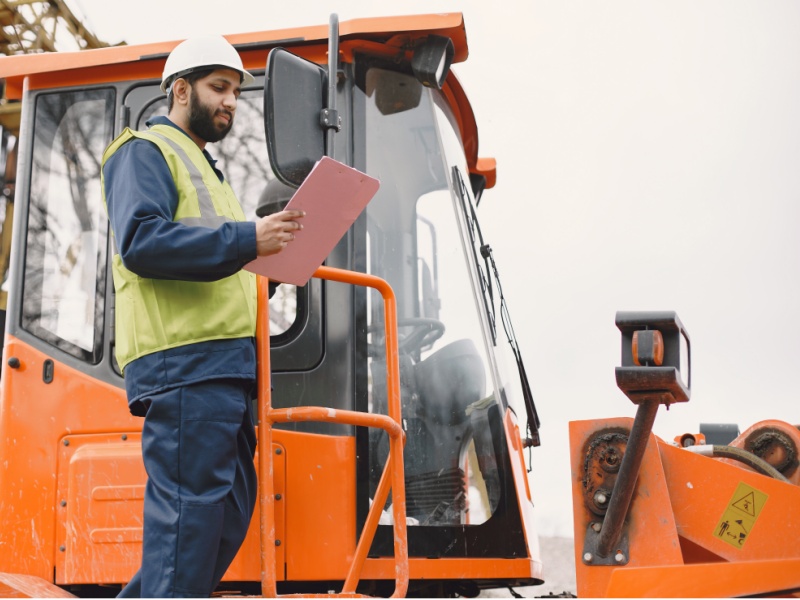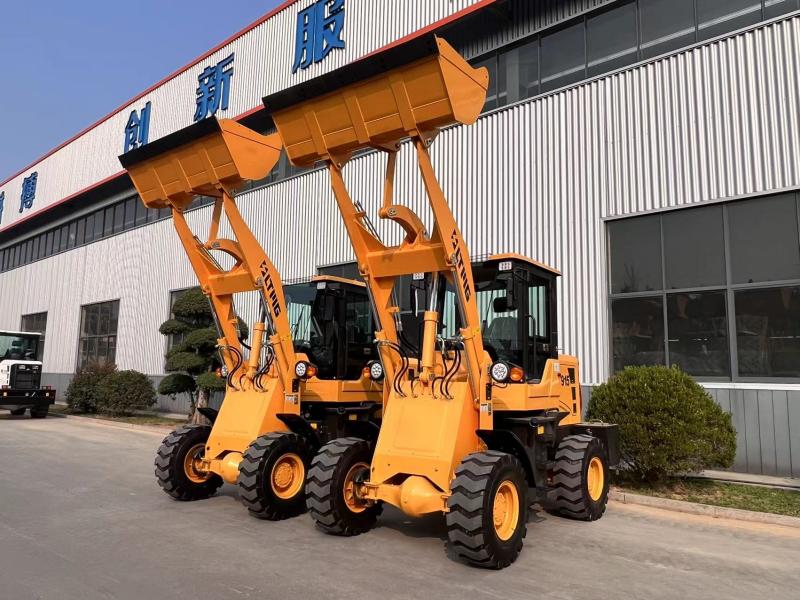Maintenez votre équipement en bon état de fonctionnement : 5 problèmes courants de chargeur et comment les résoudre rapidement
Jul 22, 2025
Chargeuses sur pneus Les chargeuses sont des équipements essentiels sur les chantiers de construction, les mines, les exploitations agricoles et les ports. Elles effectuent quotidiennement des tâches lourdes de chargement, de déplacement et de nettoyage. Cependant, comme toute machine performante, les chargeuses rencontrent inévitablement divers problèmes. Identifier et résoudre ces problèmes à temps permettra non seulement de minimiser les temps d'arrêt coûteux, mais aussi de garantir un fonctionnement sûr et de prolonger la durée de vie de l'équipement. Cet article examine en détail les cinq problèmes de chargeuses les plus courants et propose des solutions claires et réalisables pour vous aider à maintenir vos équipements au meilleur de leurs performances. Problème 1 : Réponse lente de la transmission ou glissement (problèmes de transmission)La transmission est le cœur du système d'alimentation du chargeur et son état affecte directement les capacités de déplacement et de fonctionnement de l'équipement. Symptômes courants :Les symptômes courants comprennent des changements de vitesse difficiles, un impact violent, un glissement des vitesses ou une interruption de puissance pendant la conduite, des bourdonnements ou des grincements anormaux provenant de la transmission, une température élevée de l'huile de transmission et des alarmes sur le tableau de bord. Causes profondes :Les causes profondes comprennent les problèmes d'huile, tels qu'un faible niveau d'huile de transmission, une contamination de l'huile ou l'utilisation d'un mauvais type d'huile ; le blocage du filtre, c'est-à-dire que le filtre de transmission n'a pas été remplacé depuis longtemps, ce qui entraîne un blocage du circuit d'huile ; l'usure interne, telle que l'usure des composants internes tels que les disques d'embrayage, les plaques de friction ou les engrenages ; et une défaillance de la commande électronique, c'est-à-dire une défaillance de la vanne de commande ou de l'électrovanne, entraînant l'incapacité d'exécuter correctement la commande de changement de vitesse. Solution :Vérifiez régulièrement le niveau d'huile : vérifiez quotidiennement le niveau d'huile de transmission et remplacez l'huile et le filtre à huile en respectant scrupuleusement le cycle recommandé par le fabricant. C'est la mesure préventive la plus élémentaire et la plus importante.Utilisez la bonne huile : assurez-vous de toujours utiliser une huile de transmission dédiée qui répond aux spécifications de l'équipement. Faites attention au nettoyage : gardez la transmission et le radiateur propres pour assurer de bonnes performances de dissipation de la chaleur. Diagnostic professionnel : Si le problème persiste, notamment en cas de bruit interne ou de glissement important, arrêtez immédiatement l'opération et contactez un technicien professionnel pour une inspection afin d'éviter l'extension du défaut. Problème 2 : Défaillances du système hydrauliqueLe système hydraulique est le « muscle » du chargeur, responsable de toutes les actions clés telles que le levage de la flèche et le retournement du godet. Symptômes courants :La vitesse de levage de la flèche ou de retournement du godet ralentit considérablement. Même à régime moteur élevé, la force de levage semble insuffisante. La pompe hydraulique émet un sifflement aigu. Des fuites d'huile sont visibles au niveau des joints des conduites ou des vérins hydrauliques, et la température de l'huile hydraulique est trop élevée. Cause profonde :La contamination de l'huile est la principale cause de pannes des systèmes hydrauliques. La pénétration de poussière, d'humidité ou de particules métalliques dans l'huile entraîne une usure rapide de la pompe, de la soupape et du vérin ; l'obstruction de l'élément filtrant (y compris les éléments d'aspiration et de retour d'huile) entraîne une alimentation en huile insuffisante ; le niveau d'huile est trop bas (le niveau d'huile dans le réservoir d'huile hydraulique est inférieur à la norme), ce qui provoque une aspiration d'air par le système. L'usure des composants clés, comme la pompe hydraulique, la soupape de commande principale ou les joints internes du vérin, entraîne des fuites internes et une incapacité à générer de la pression. Solution :Maintenir l'huile propre : remplacez régulièrement l'huile hydraulique et tous les éléments filtrants. Lors de l'ajout ou du remplacement d'huile hydraulique, veillez à la propreté de l'environnement et des outils.Inspection quotidienne : vérifiez le niveau d'huile hydraulique avant de commencer le travail tous les jours, inspectez tous les tuyaux et joints hydrauliques et traitez les fuites à temps. Évitez la surcharge : un fonctionnement en surcharge à long terme accélérera l'usure des pompes et des vannes hydrauliques. Test de pression professionnel : S'il y a une faiblesse dans le mouvement, demandez aux techniciens d'utiliser un manomètre professionnel pour tester la pression du système afin de localiser avec précision le point de défaut. Problème 3 : Difficulté à démarrer le moteur ou fumée noire (Problèmes de moteur)Le moteur est le cœur du chargeur et tout problème avec celui-ci peut entraîner l'arrêt complet de l'équipement. Symptômes courants :Les symptômes courants incluent des difficultés de démarrage lorsque le moteur est froid ou chaud, nécessitant plusieurs tentatives, une puissance insuffisante lors du fonctionnement, une sensation de « faiblesse », une fumée de couleur anormale sortant du tuyau d'échappement (fumée noire : combustion incomplète ; fumée bleue : huile brûlante ; fumée blanche : le carburant contient de l'eau ou du liquide de refroidissement pénètre dans le cylindre), et la température de l'eau du moteur est trop élevée, ou il y a un bruit de cognement anormal lors du fonctionnement. Causes profondes :Les causes profondes incluent le système de carburant, comme un filtre diesel obstrué, une mauvaise atomisation de l'injecteur ou une mauvaise qualité du carburant ; dans le système d'admission, le filtre à air est gravement obstrué, ce qui entraîne une admission d'air insuffisante ; dans le système de refroidissement, le radiateur est obstrué, le thermostat est défectueux ou le liquide de refroidissement est insuffisant, ce qui entraîne une surchauffe du moteur ; il existe également des problèmes avec le système de lubrification, c'est-à-dire une faible pression d'huile ou une huile insuffisante. Solutions:Appliquer strictement l'entretien : Conformément au manuel d'entretien, remplacez les « trois filtres » (filtre moteur, filtre diesel, filtre à air) et l'huile moteur à temps. Assurez la qualité du carburant : ajoutez du diesel propre et qualifié provenant des canaux réguliers. Gardez le radiateur propre : utilisez régulièrement de l'air comprimé pour souffler la poussière et les débris sur la surface du radiateur. Soyez attentif au tableau de bord : soyez toujours attentif aux indicateurs clés tels que la jauge de température d'eau et la jauge de pression d'huile, et arrêtez immédiatement la machine pour une inspection si vous constatez une anomalie. En cas de problèmes tels que de la fumée noire, commencez généralement par vérifier le filtre à air et le filtre à gasoil. Problème 4 : Usure excessive ou dommages aux pneus (problèmes de pneus/roues)Le pneu est la seule partie du chargeur qui entre en contact avec le sol et son état affecte directement la traction, la stabilité et même la sécurité opérationnelle de l'équipement. Symptômes courants :Usure inégale de la bande de roulement, telle qu'une usure excessive au milieu, sur les côtés ou sur certaines parties, des fissures et des renflements sur le flanc du pneu, ou une perforation de la bande de roulement par des objets pointus, des bosses anormales ou des secousses de la carrosserie pendant la conduite, une baisse fréquente de la pression des pneus, un besoin fréquent de remplissage d'air, des boulons de moyeu de roue desserrés ou une déformation et des fissures sur la jante. Causes profondes :Pression des pneus inadéquate. Une pression trop élevée peut entraîner une usure importante au milieu de la bande de roulement. Une pression trop basse peut entraîner une usure des deux côtés et augmenter le risque d'éclatement. Une surcharge prolongée, c'est-à-dire un fonctionnement continu au-delà de la charge nominale, exerce une pression importante sur la structure du pneu. Des conditions de travail difficiles, comme la conduite fréquente sur des pierres coupantes, des débris de construction ou des terrains accidentés, ainsi que de mauvaises habitudes de conduite, comme les virages serrés, les virages sur place et la course rapide vers le tas de matériaux, peuvent endommager gravement les pneus. Il faut également mentionner les négligences en matière d'entretien, c'est-à-dire le non-nettoyage à temps des pierres incrustées dans la bande de roulement et le non-serrage des boulons de moyeu de roue au couple spécifié. Solution :Contrôle quotidien de la pression des pneus : Lorsque le pneu est froid, utilisez un manomètre pour vérifier la pression et l'ajuster à la valeur standard recommandée par le fabricant avant de commencer à travailler. Inspectez visuellement : faites le tour du véhicule pour vérifier la présence de coupures et de bosses visibles sur la surface du pneu, et nettoyez à temps les pierres et autres corps étrangers incrustés dans la bande de roulement.Fonctionnement de conduite standard : évitez la surcharge, réduisez la conduite à grande vitesse et les virages serrés et approchez-vous en douceur lors du pelletage des matériaux.Serrage et inspection réguliers : utilisez une clé dynamométrique pour vérifier et serrer régulièrement tous les boulons du moyeu de roue. Vérifiez également si la jante est déformée ou fissurée.Choisissez le bon pneu : Choisissez des pneus avec des motifs et des degrés de résistance à l'usure correspondants en fonction des principales conditions de travail (telles que terrassement, chantier de pierre, chantier de charbon, etc.). Problème 5 : Défaillance du système électrique (problèmes électriques)Les chargeurs modernes s'appuient de plus en plus sur des systèmes électriques complexes pour contrôler et surveiller l'état de l'équipement. Symptômes courants :Les phares et les feux de travail sont éteints ou clignotent, le démarreur ne répond pas ou est incapable de tourner, la batterie est fréquemment épuisée et les voyants du tableau de bord, les instruments ou les écrans d'affichage ne fonctionnent pas correctement. Causes profondes :Problèmes de batterie, tels que le vieillissement de la batterie, la corrosion de la tête de pieu ou des connexions desserrées ; panne du générateur, c'est-à-dire que le générateur ne peut pas charger la batterie normalement ; dommages à la ligne, tels que le vieillissement, la rupture, le court-circuit ou le mauvais contact des connecteurs ; et fusible grillé, c'est-à-dire qu'une surcharge du circuit ou un court-circuit provoque la combustion du fusible. Solution :Entretien de la batterie : Maintenez les bornes de la batterie propres et bien serrées, et appliquez du beurre pour éviter la corrosion. Vérifiez régulièrement le niveau d'électrolyte (le cas échéant).Vérifiez le générateur : vérifiez régulièrement la tension de la courroie du générateur. Si la batterie est souvent faible, vérifiez la tension de charge du générateur.Protégez le câblage : Protégez le faisceau de câbles de l'ensemble du véhicule pour éviter qu'il ne soit écrasé, frotté ou exposé à l'huile et aux températures élevées. Vérifiez le fusible : Si un appareil électrique ne fonctionne pas, vérifiez d'abord la boîte à fusibles correspondante. Conclusion : Mieux vaut prévenir que guérirLa gestion d'une chargeuse sur pneus nécessite l'établissement d'un plan d'inspection quotidienne strict et d'entretien régulier, afin que vous puissiez découvrir et résoudre à l'avance la plupart des problèmes ci-dessus. Une gestion rapide des petits problèmes est le meilleur moyen d'éviter qu'ils ne se transforment en révisions coûteuses et en longues immobilisations. Intégrez la maintenance préventive à vos tâches quotidiennes et votre chargeuse vous rentabilisera grâce à une efficacité accrue, une durée de vie prolongée et des performances plus sûres.

